Pros
Cons
The iPhone 5s (MSRP $649.00, $199 on-contract from major providers) is a great example of these design principles at work. From top to bottom it is an extremely well-honed phone. It feels fantastic, it operates smoothly, and the flat design of iOS 7 is simply gorgeous. It's a beautiful phone, both inside and out.
On paper, however, the iPhone 5s gives up quite a bit to the competition. It has a smaller battery, a lower resolution screen, and less RAM than just about every other flagship smartphone on the market. Apple has added in some innovative features like a fingerprint scanner on the home button, but is Apple's legendary design philosophy enough to overcome a significant hardware gap?
Design
All the geeks go crazy for a sharp-dressed phone.
Clad in metal where it counts and lightweight plastic where it doesn't, the 5s feels solid from the moment you pick it up. The body has zero flex, is thin enough to fit easily into anybody's hand, and the entire screen and all the controls are easily reached. Below the screen you'll find a redesigned, physical home button hiding a fingerprint scanner. Below that, you'll find the speakers on the bottom of the phone, along with the Lightning connector for data transfer/charging, and the 3.5mm headphone jack.
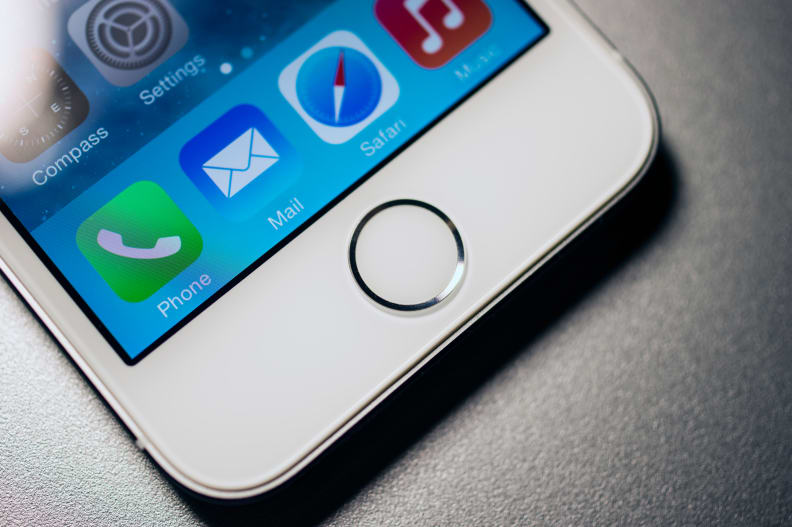
Physical buttons may no longer be en vogue, but this one is quite useful.
The screen of the iPhone 5s has mostly been discussed in terms of its physical size. As debuted on the iPhone 5, the 5s' screen is taller than the original iPhone displays. It's 4 inches diagonally, which despite the increased height is still smaller than nearly every other flagship phone on the market. It's more than large enough for basic tasks, but if you've fallen in love with a larger phone from the 5-inch-and-up category, the 5s is simply going to feel tiny.
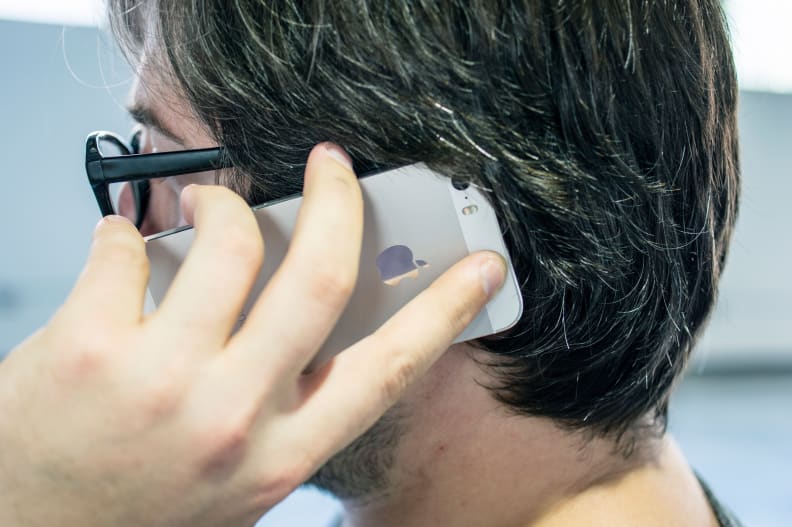
Sure, the phone is small. But it's appropriately sized for its intended use.
From a usability perspective, the smaller screen is a joy. You can reach every inch of the display without having to engage in some thumb gymnastics, making for a much more secure single-handed experience. Apple's updated iOS 7 also makes the phone a much more pleasant experience. The flat design ethos—seen elsewhere but applied extensively by Apple here—makes for a much more unified, clean experience. The OS is flat-out gorgeous. There are times when Apple went a little too far in the minimalist direction, however, so there are times when an important button—the download button in the App store, for example—doesn't stand out enough.
{{ photo_gallery name="tour" }}
Of the new features in the iPhone 5s, the one you'll probably interact with the most is the fingerprint scanner. Though fingerprint scanners have shown up on phones like the Motorola Atrix 4G before, Apple's implementation here is by far the most consistent and the most accurate. The phone puts you through an extensive setup process before the feature is used, ensuring that it can tell you're really you even if it only gets a partial fingerprint. It's not perfect—no fingerprint scanner is—but after testing a bunch of phones I can say it works better than previous efforts.
User Experience
Simple and beautiful—iOS 7 is a hit.
Apple announced iOS 7 last June at its annual Worldwide Developers Conference and is poised to release iOS 8 this fall. As the first major iOS redesign in some time, iOS 7 comes packed with all sorts of nips and tucks that improve the look and feel of the entire operating system. If you owned an older iPhone and just never bothered to upgrade, you should be able to find your way around without much trouble. If you've never used an iPhone at all, you'll probably still find your way around, but it might take a little getting used to.
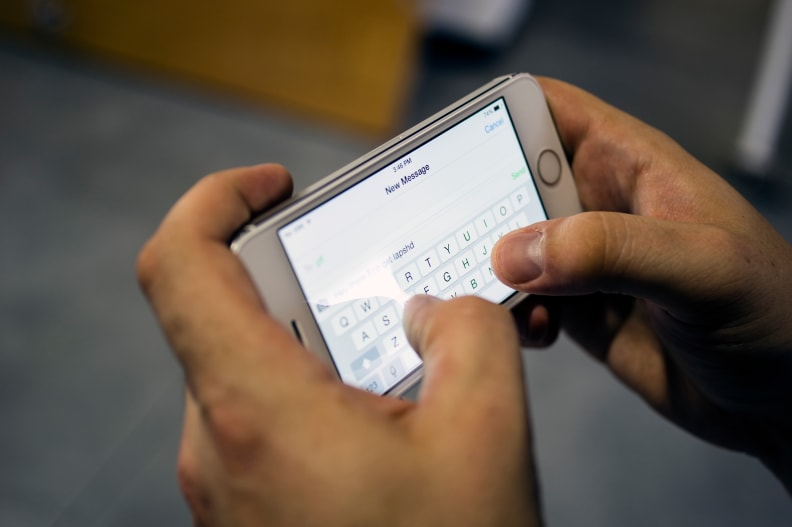
It's no Android keyboard, but iOS7 handles typing in landscape position fairly well.
From a user's perspective, the major differences in iOS 7 are visual. Fonts are thinner, drop shadows and gradients have given way to flat design principles, and the color palette is more reserved. The entire experience feels updated and modern—though if this isn't your first iPhone then you'll still feel right at home. Functionally, the biggest change is probably to the notification center. You can now better view notifications without having to unlock your phone and everything is a little more customizable. It doesn't quite match the plethora of options on most high-end Android devices, but it runs smoothly, gets the job done, and holds the fort until iOS 8 drops.
Personalization is at a premium, unfortunately, but that's to be expected with such a tightly designed operating system. Widgets will finally make their appearance in the upcoming iOS debut, but currently your homescreens will be just be loaded up with all of your apps in one big carousel. By eschewing the app drawer found on most Android phones the experience is much simpler—just swipe left or right and all your apps can be found—but if you just want a clean, clutter-free homescreen you're out of luck.
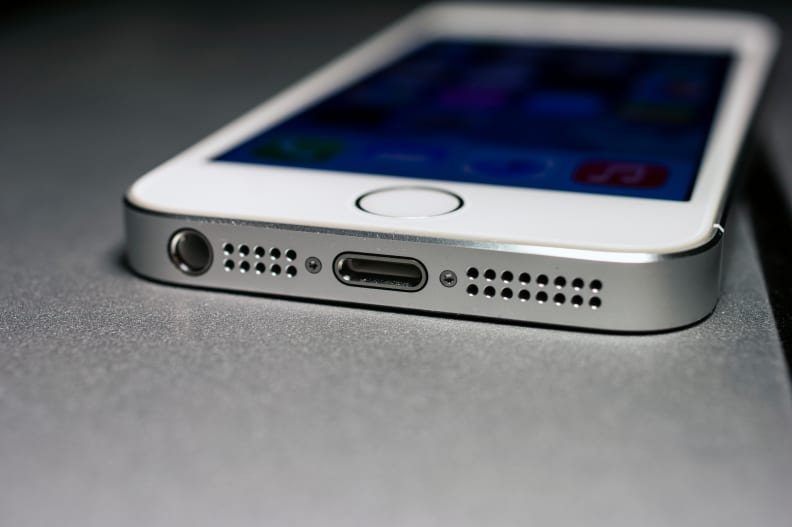
The bottom of the phone seems crowded, but you'll be thankful these items are where they are.
And as it has been for years, Apple's App Store is still the largest and most robust application market out there. Though you can't run or sideload independent apps like you can on Google's devices, just about every major app hits the iOS market first. While most of the services you use today probably have both Android and iOS apps, there's always the threat of a new startup that launches on iOS only, adding Android compatibility down the line.
Performance
Despite some stiff competition, Apple's flagship chip still holds its own.
Now that the iPhone 5s is starting to show its age, it's starting to lag a little bit behind other phones that are flooding the market. It no longer has the best screen, or the best specs, but it still works famously. It's still the only major phone on the market with a 64-bit chip inside, and it runs everything you need for it to work extremely well.
As it sits, the A7 CPU/M7 co-processor tandem kicks a lot of butt in benchmark tests—even when compared to phones with much more juiced-up hardware. Though the iPhone itself has to get by with just 1 GB of RAM (as opposed to something like the 3GB of RAM found in the LG G3), because it has a relatively low res screen and a very solid CPU, performance doesn't feel hamstrung.
However, it does have a few sore spots. The screen, as we just mentioned, is relatively low res at just 1136x640. That's less than even 1280x720p HD content—let along 1080p full HD—so watching videos on the screen may result in some weird aliasing errors. For other tasks you will hardly notice, however, as the displays has a pixel density of right around 325ppi—more than exceeding Apple's "Retina" standard.
The panel itself is pretty well-calibrated, with a fairly accurate color gamut. The screen only has so-so contrast in our lab tests due to a relatively high black level, but it has a fantastically bright screen. That really pays dividends when you're trying to view the iPhone outside, and it's brighter than competing phones like the Samsung Galaxy S5 and the LG G3.
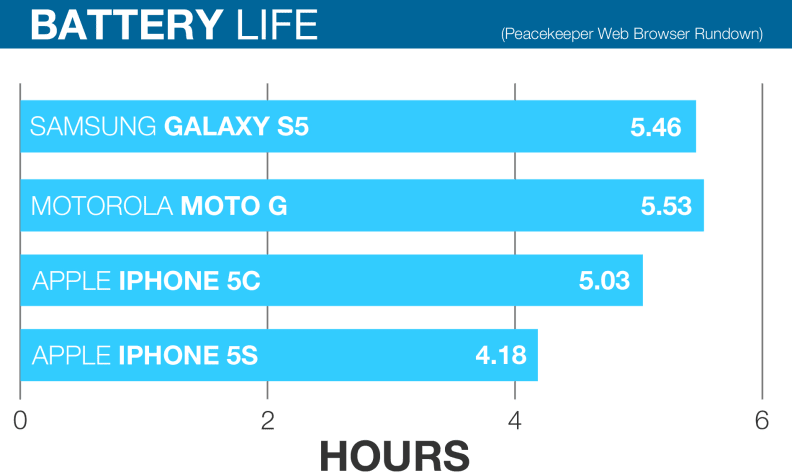
The iPhone 5s has generally good battery life, but under heavy browser load it fell behind the competition.
If you need a companion for the plane or a long car trip, the iPhone 5s should have you covered, but under heavy browser load the phone stumbles a bit. Putting it under an extreme browsing load with the Peacekeeper benchmark, the 5s was only able to keep up for just over four hours before dying. That's a pretty respectable result in general—good for all-day usage, at least—but competing flagships lasted in excess of five and a half hours in the same test, while some budget phones crushed it handily.
To its credit, the 5s charges very quickly with the included charger and Lightning connector. Even if you only have a few minutes to spare, you can top off your battery relatively easily if you can find an outlet or USB port. Considering how long it takes other phones like LG's G3 to charge, a quick charge time is a blessing. The exclusive Lightning connector is also symmetrical, so though your old iPhone accessories may not be compatible, at least you can easily plug your brand-new cable without even looking at it.
Camera
It's not the best camera on the market, but it's better than average.
Smartphone photography is as popular as ever, and a big part of that has been the improved quality of smartphone cameras—especially those found in iPhones. The 5s is no different here, with an 8-megapixel sensor and a maximum aperture of f/2.2. Though it's not nearly as good as a dedicated camera at this price point, but in the smartphone arena there's not much better out there.
We put the iPhone 5s through a variety of tests both in and out of our camera lab, and it mostly held its own. In bright light the 5s takes shots that have a pleasing level of oversaturation and acceptable color accuracy, about on par with your average entry-level point-and-shoot.
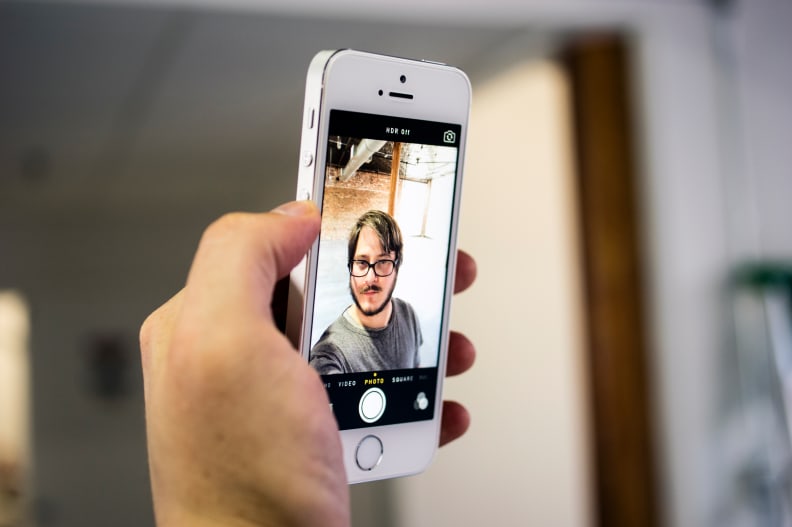
This is the original selfie-phone.
In our sharpness test we were mostly pleased with what the 5s could do. The camera was able to resolve roughly 1750 line widths per picture height, with only a slight bit of edge enhancement. That's not quite a sharp as what the Samsung Galaxy S5 managed, but the S5 also added about 20% oversharpening to achieve that result. When you correct for that the iPhone 5s is actually the sharper of the two.
In low light the iPhone 5s predictably begins to struggle, as its small image sensor just can't gather enough light to produce great photos all of the time. The images get much grainier, though Apple avoids the temptation to hammer the shots with tons of noise reduction—something its competitors do far too much. The result is that the 5s' shots often look a little noisier than the competition, but there's far more fine detail to go with it.

The photos may be taken by a smartphone, but they look great.
Video quality on the iPhone 5s is about par for the course with smartphones. Though the iPhone can handle 1080p output, it does struggle a little bit when capturing motion. Compared to most point and shoots—which are capable of recording video at 500-600 line pairs per picture height (LP/PH), the iPhone 5s' tiny camera can only manage roughly 400 LP/PH. That's still not bad, however, and exceeds even the 4K video we've seen from newer flagships from Samsung and LG.
If we had one gripe with the camera, it's that the iPhone doesn't offer expandable storage or SD card support. As anyone who has owned an iPhone for a long period of time will tell you, you can fill up even 64GB of space quicker than you think. If you do go with the iPhone—or any smartphone, really—we highly recommend setting up a cloud backup solution as soon as you can.
{{ photo_gallery "sample-photo" }}
Conclusion
When it comes to Apple's flagship, you get what you pay for.
Apple has long held the smartphone championship belt with a one-two punch of great software and hardware, but a never-ending series of flagship Android devices have closed the gap considerably. Especially at the top end, choosing between Apple and Android is mostly a matter of personal preference.
If you've used an iPhone before and you loved it, we wholeheartedly recommend that you pick up the 5s. It's the best phone in Apple's stable of devices, and with iOS 7 it's one of the best smartphones ever made. It runs basically every (Apple-approved) app under the sun, has one of the best cameras available in smartphones today, and you get flagship-level performance and battery life that should easily last you an entire working day.
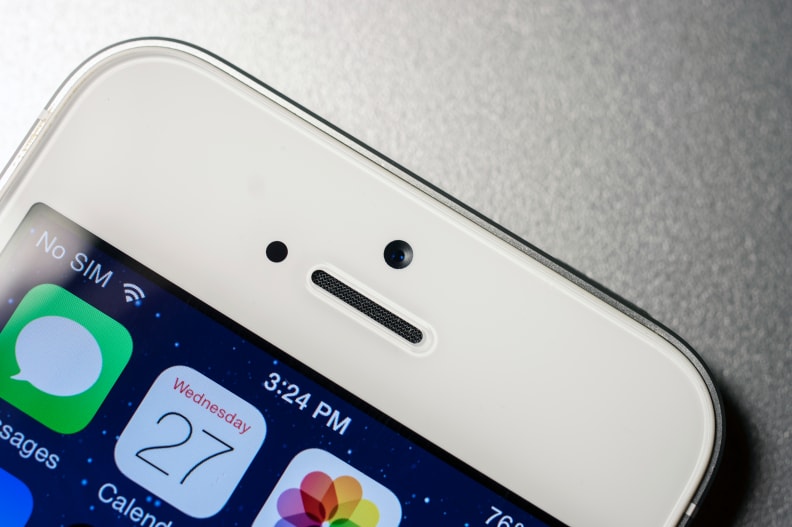
Be sure to wipe off the earpiece if you use FaceTime.
The biggest reservation we have about recommending the iPhone 5s, it's that it's rather late in the product's lifespan. If you're signing up for a new two-year contract, you should know that Apple is widely expected to update its iPhone lineup this fall. By the time you're reading this, it may have already happened. The 5s is good and certainly worth the money, but Apple's next phone could be a significant upgrade that might be worth the wait.
For those who don't have one platform preference over the other, picking between Android and iOS is primarily a matter of freedom vs. design; Android provides far more freedom to customize your experience, iOS provides you with a curated, clean, well-manicured experience without having to take any time to set it up the way you want it. The iPhone 5s is, for now, the best version of that experience you can get on a mobile phone. It's a fantastic all-around phone that should feel snappy and modern for years to come.
Meet the tester
A seasoned writer and professional photographer, Chris reviews cameras, headphones, smartphones, laptops, and lenses. Educated in Political Science and Linguistics, Chris can often be found building a robot army, snowboarding, or getting ink.
Checking our work.
Our team is here to help you buy the best stuff and love what you own. Our writers, editors, and experts obsess over the products we cover to make sure you're confident and satisfied. Have a different opinion about something we recommend? Email us and we'll compare notes.
Shoot us an email


